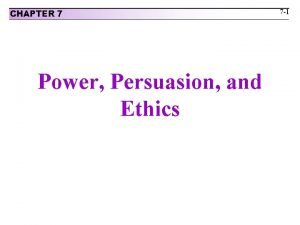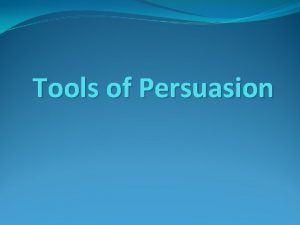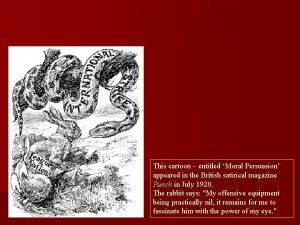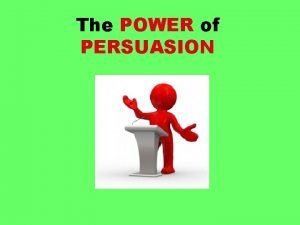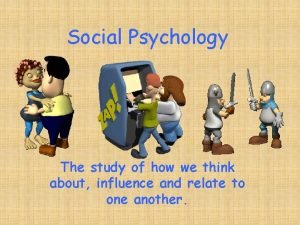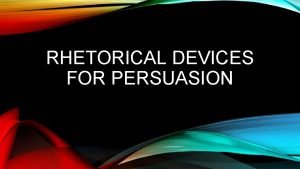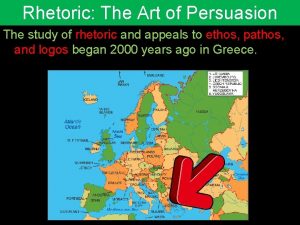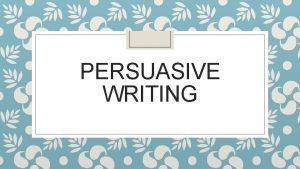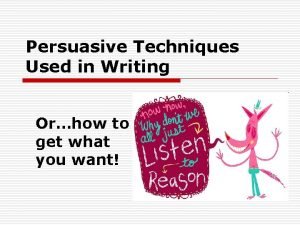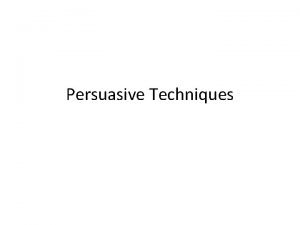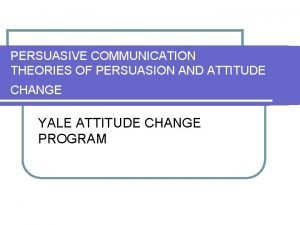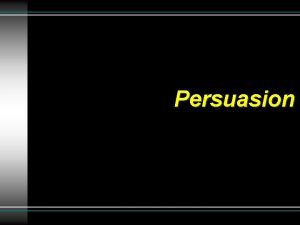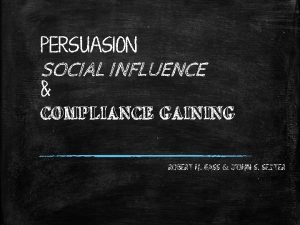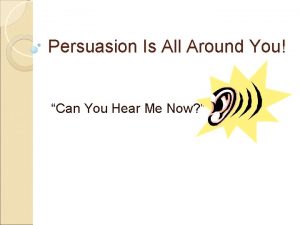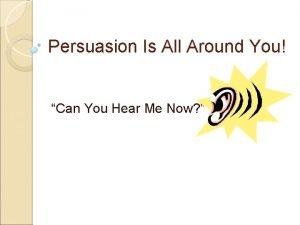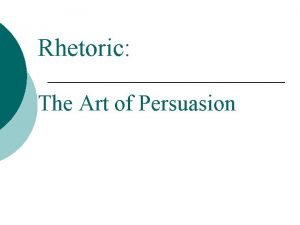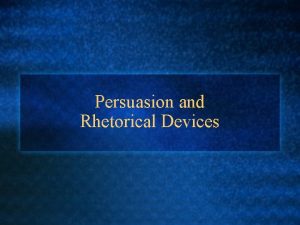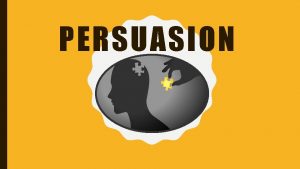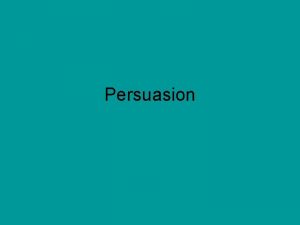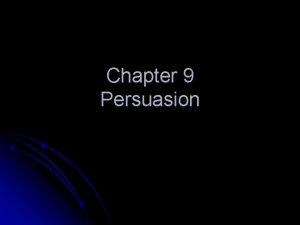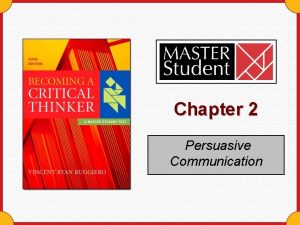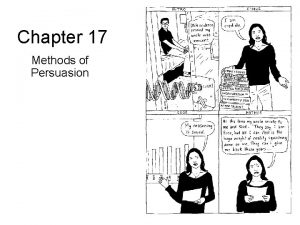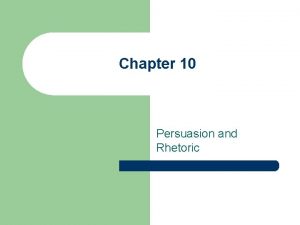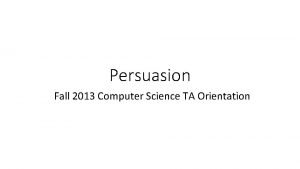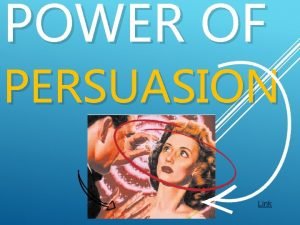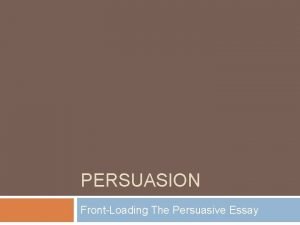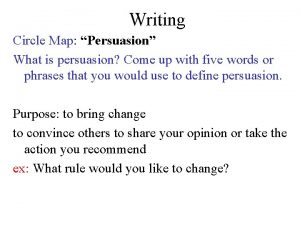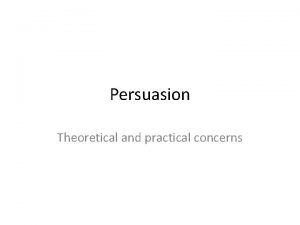Chapter 7 Persuasion Jim WestAlamy Copyright 2016 Mc




























- Slides: 28

Chapter 7: Persuasion Jim West/Alamy Copyright 2016 © Mc. Graw-Hill Education. Permission required for reproduction or display

Persuasion Process by which a message induces change in beliefs, attitudes, or behaviors Persuasion is a process that can be aimed to induce positive changes (such as toward healthier life style) or negative (such as the Nazi propaganda machine, described at the beginning of the chapter) The topic of persuasion was studied by Yale professor Carl Hovland during World War II (1939 -1945) in order to boost soldiers’ morale Copyright 2016 © Mc. Graw-Hill Education. Permission required for reproduction or display.

The Yale Model (Hovland) Elements of Persuasion The Communicator: Who delivers the message and what are his/her successful attributes? The Content of the message: For example, emotions vs. reason; the impact of raising fear; Primacy vs. Recency The Channel of communication The Audience to who to message is conveyed

What Paths Lead to Persuasion? Central Route Occurs when interested people focus on the arguments and respond with favorable thoughts Peripheral Route Occurs when people are influenced by incidental cues, such as a speaker’s attractiveness Focuses on cues that trigger automatic acceptance without much thinking Copyright 2016 © Mc. Graw-Hill Education. Permission required for reproduction or display.

What Paths Lead to Persuasion? Different Paths for Different Purposes Peripheral route Superficial and temporary attitude change Central route More durable and more likely to influence behavior Copyright 2016 © Mc. Graw-Hill Education. Permission required for reproduction or display.

Central and Peripheral Routes

Central and Peripheral Routes to Persuasion The Hurdles of the Persuasion Process Copyright 2016 © Mc. Graw-Hill Education. Permission required for reproduction or display.

What Are the Elements of Persuasion? Who Says? The Communicator Credibility Believability Sleeper effect Delayed impact of a message that occurs when an initially discounted message becomes effective, as we remember the message but forget the reason for discounting it Copyright 2016 © Mc. Graw-Hill Education. Permission required for reproduction or display.

What Are the Elements of Persuasion? Who Says? The Communicator Credibility Perceived expertise: begin by saying things the audience agrees with Introduce someone who is knowledgeable on the topic Speaking Style: Speak confidently and fluently Perceived trustworthiness Eye contact The Communicator does not appear to try to persuade Arguing against own self-interest Speak quickly; the audience is less likely to evoke counterarguments Copyright 2016 © Mc. Graw-Hill Education. Permission required for reproduction or display.

What Are the Elements of Persuasion? Who Says? The Communicator Attractiveness and Liking Physical attractiveness: There is an elements of being esthetically- rewarded; it pleases us to view something that or someone who is physically-appealing Similarity: We tend to like people who resemble us (ads that had youth appealing tom other youth in an anti-smoking campaign were quite effective) People who act as we do, mimicking our posture, are more influential in their persuasive attempts People are more likely to responds to a message that comes from someone from their group. Copyright 2016 © Mc. Graw-Hill Education. Permission required for reproduction or display.

Similarity of Expertise? When the choice concerns matters of personal value, taste, or way of life, similar communicators have more influence (e. g. in commercials who show people like us who bought a household item) On matter of judgment of facts, e. g. which fact is true, a dissimilar person may be more influential in attempts persuade

What Are the Elements of Persuasion? What Is Said? The Message Content Reason versus Emotion: Is logical message more persuasive, or one that arouses emotion? Effect of good feelings Effect of arousing fear Copyright 2016 © Mc. Graw-Hill Education. Permission required for reproduction or display.

Message Content: Reason vs. Emotion When soliciting donations to fight world hunger, should the message rely on statistics (logic) or on a picture of one starving child (emotion)? It depends on the audience; well-educated, analytical people respond to rational appeals Most audiences are uninvolved and are more likely to respond to an emotional message When people’s initial attitudes are formed via emotion they are more likely to respond to emotional messages

Message Content: The Effect of Good Feelings Messages become more persuasive through associations with good feelings Subjects were more likely to be affected by a message if allowed to eat and drink while listening to it People who are in a good mood view the world more positively; they also make faster, more impulsive decisions and rely more on peripheral cues Unhappy people ruminate more and are less lilkely to be affected by weak arguments

Message Content: The Effect of arousing Fear In general messages can be effective by arousing fear Including picture of the hazards of smoking on each pack of cigarettes affected smokers How much fear is effective? In general, the more frightened, the more people react in the direction of the message Fear-framed messages work better when trying to prevent a bad outcome than trying to promote bad outcomes (see textbook for examples) Aronson claims that when fears relates to a pleasurable activity the response might be denial

What Are the Elements of Persuasion? What Is Said? The Message Content • Foot-in-the-Door Phenomenon Tendency for people who have first agreed to a small request to comply later with a larger request Low-ball technique Tactic for getting people to agree to something. People who agree to an initial request will often still comply when the requester ups the ante Used by some car dealers Copyright 2016 © Mc. Graw-Hill Education. Permission required for reproduction or display.

What Are the Elements of Persuasion? What Is Said? The Message Content One-sided versus two-sided appeals Which one is more effective? Depends on whether the audience already agrees with the message; if the audience is unaware of opposing arguments, it is unlikely later to consider the opposition Copyright 2016 © Mc. Graw-Hill Education. Permission required for reproduction or display.

What Are the Elements of Persuasion? What Is Said? The Message Content Primacy versus recency Primacy effect Other things being equal, information presented first usually has the most influence Recency effect Information presented last sometimes has the most influence. Recency effects are less common than primacy effects Copyright 2016 © Mc. Graw-Hill Education. Permission required for reproduction or display.

Primacy vs. Recency

What Are the Elements of Persuasion? How Is It Said? The Channel of Communication Active experience or passive reception? Active experience strengthens attitudes Repetition and rhyming of a statement serves to increase its fluency and believability Copyright 2016 © Mc. Graw-Hill Education. Permission required for reproduction or display.

What Are the Elements of Persuasion? How Is It Said? The Channel of Communication Personal versus media influence Media influence: The two-step flow Process by which media influence often occurs through opinion leaders, who in turn influence others Copyright 2016 © Mc. Graw-Hill Education. Permission required for reproduction or display.

What Are the Elements of Persuasion? How Is It Said? The Channel of Communication Personal versus media influence Comparing media The more lifelike the medium, the more persuasive its message Copyright 2016 © Mc. Graw-Hill Education. Permission required for reproduction or display.

What Are the Elements of Persuasion? To Whom Is It Said? The Audience How old are they? Life cycle explanation Attitudes change as people grow older Generational explanation Attitudes do not change; older people largely hold onto the attitudes they adopted when they were young Copyright 2016 © Mc. Graw-Hill Education. Permission required for reproduction or display.

What Are the Elements of Persuasion? To Whom Is It Said? The Audience What are they thinking? Forewarned is forearmed—If you care enough to counterargue Distraction disarms counterarguing Words can promote candidate/product Visual images keep us occupied so we don’t analyze the words Copyright 2016 © Mc. Graw-Hill Education. Permission required for reproduction or display.

What Are the Elements of Persuasion? To Whom Is It Said? The Audience What are they thinking? Uninvolved audiences use peripheral cues Ways to stimulate people’s thinking Use rhetorical questions Present multiple speakers Make people feel responsible Repeat the message Get people’s undistracted attention Copyright 2016 © Mc. Graw-Hill Education. Permission required for reproduction or display.

How Can Persuasion Be Resisted? Strengthening Personal Commitment Challenging beliefs Developing counterarguments Attitude inoculation Exposing people to weak attacks upon their attitudes so that when stronger attacks come, they will have refutations available Copyright 2016 © Mc. Graw-Hill Education. Permission required for reproduction or display.

How Can Persuasion Be Resisted? Real-Life Applications: Inoculation Programs Inoculating children against: Peer pressure to smoke The influence of advertising Copyright 2016 © Mc. Graw-Hill Education. Permission required for reproduction or display.

How Can Persuasion Be Resisted? Prepare others to counter persuasive appeals An ineffective appeal can be worse than none A way to strengthen existing attitudes is to weakly challenge them Copyright 2016 © Mc. Graw-Hill Education. Permission required for reproduction or display.
 Persuasion chapter 9
Persuasion chapter 9 Persuasion chapter 7
Persuasion chapter 7 The new jim crow chapter 1
The new jim crow chapter 1 The new jim crow chapter 2
The new jim crow chapter 2 Rank's model of persuasion
Rank's model of persuasion Tools of persuasion
Tools of persuasion Rabbit and snake league of nations cartoon
Rabbit and snake league of nations cartoon Persuasive format
Persuasive format Persuasión instintiva
Persuasión instintiva What is persuasion theory
What is persuasion theory What is persuasion matrix
What is persuasion matrix Peripheral route persuasion example
Peripheral route persuasion example Cognitive dissonance
Cognitive dissonance Impression formation
Impression formation Rhetorical devices
Rhetorical devices Ethos pathos logos kairos
Ethos pathos logos kairos Which greek philosopher defined the art of persuasion
Which greek philosopher defined the art of persuasion Coercive power
Coercive power A writer who writes persuasive pieces attempts to:
A writer who writes persuasive pieces attempts to: Persuasion mcqs with answers
Persuasion mcqs with answers Emotional appeal examples
Emotional appeal examples Repetition figure of speech examples
Repetition figure of speech examples Persuasive communication theories
Persuasive communication theories What is persuasion
What is persuasion Persuasion social influence and compliance gaining
Persuasion social influence and compliance gaining All around you
All around you Persuasion is all around you
Persuasion is all around you Passive persuasion
Passive persuasion Persuasion process
Persuasion process

